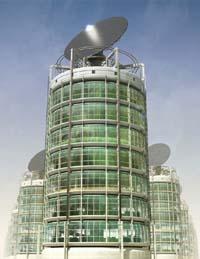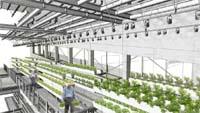Vertical farmhouses
2007/11/03 Galarraga Aiestaran, Ana - Elhuyar Zientzia

According to the researchers, vertical farmhouses are now the best solution for society and especially to face the problems it will have in the future. In fact, by 2050 the population will increase considerably, and the most modest forecasts suggest that the world will have 3,000 million more inhabitants than today, of which about 80% will reside in cities. With current agricultural and livestock methods, more than one billion hectares of land should be devoted to food production, 20% more than the surface of Brazil.
The land cannot bear it, so those in Columbia believe that solutions must be thought of and propose that agricultural and livestock activities take place in thirty-story skyscrapers.
In fact, growing vegetables and animals inside the house is not new; many of the foods we eat today are raised internally: fruits and vegetables grow in greenhouses, pigs and chickens in nurseries, and fish. The researchers have gone from there, but they have improved the system so as not to harm the environment, make the most of the resources and be located in the cities. The result is a vertical hamlet, or what is the same, a hamlet inside a skyscraper.
Many advantages
It has important advantages over conventional models. On the one hand, there is no transportation expense, since what is consumed in the city occurs in the city itself. On the other hand, the system is completely closed: the remains of a process are used to feed others, thus avoiding the generation of waste. In addition, being all factors fully controlled, the harvest is guaranteed. As if that were not enough, there are no parasites or bugs, so it is not necessary to use pesticides. That is, the foods raised in the vertical farmhouse would be organic. All this, according to the researchers.
They also mention more advantages, such as the land now used for the breeding of plants and animals being free. Thus, forests cleared to become the first field would become backward forests, which would positively impact climate change.
All this has been achieved by incorporating all the processes in the design of the hamlet. First, the materials have been selected based on their environmental impact. The building has a circular plan, which is the best for taking advantage of space and luminosity, and all the walls are made of glass. This glass is special as it becomes more transparent or opaque depending on the exterior luminosity and interior needs. It also has contaminant absorption capacity in the air.
The main source of energy is the sun, as through solar panels you will get most of the energy needed. In addition, a small wind turbine has been installed on the roof, which aims to generate methane as fuel by composting plant and animal remains. The methane released by the animals would also be collected.

On the other hand, all types of production are divided into modules to facilitate changes depending on the needs. One of the modules, perhaps the most important, is the control room from which the parameters of all processes are controlled. In the vertical farmhouse the temperature, humidity and air composition are fully controlled to adapt to the needs of each production.
Water management has also been designed. For example, hydroponic plant breeding systems will be used, and all water used with plants and animals (animals and fish) will be purified and reused. The building also has evaporated water recovery systems that prevent water loss. And so with all raw materials and waste.
In fact, many of the systems and materials used in the vertical farmhouse are already invented and, to some extent, used in intensive agriculture and livestock farming. Perhaps the greatest contribution of Columbia researchers is to integrate everything, place it vertically and place it in the city.
How many vertical farmhouses should be built to meet the food needs of the entire population? According to calculations, a building of these characteristics produces in a year the same amount of food as 50,000 people. But only 150 buildings would be needed in New York. Although researchers have set the target in 2050, it does not seem easy to carry out. However, some of the modules they have developed have already begun to apply and say they are having good results. At least, the work of researchers (and the time and money employed) has not been useless.
Published in Gara

Gai honi buruzko eduki gehiago
Elhuyarrek garatutako teknologia





